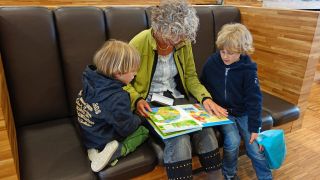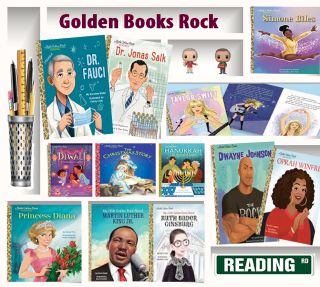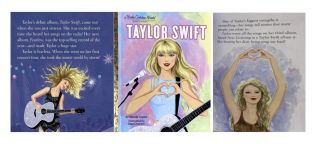Consumer Behavior
A Children's, Now Adult, Tradition Taking on Pop Culture
A Personal Perspective: Iconic gifts are flying off shelves after 80-plus years.
Updated January 26, 2024 Reviewed by Lybi Ma
Key points
- Academics note how adults gravitate to children's book — a rarely known fact.
- Little Golden Books, 80 years strong, Inspire dreams, celebrate inner strength and motivate all ages.
- Kids' lit allows an escape into childhood creativity and imagination while reducing stress.
- Publishers initially paused on a Taylor Swift title, but it's now the fastest selling Little Golden Book.
They’re iconic, visually recognized by gold-embossed spines. They were first fiction, now inspiring biographies that bring traditional reading pleasure, knowledge, and culture into the hands of all ages.
You likely read several as a child. Purchased them for your children or grandchildren. And now, enjoying them as an adult conveys a bevy of benefits, per the staff at A Lit Life, an Internet site begun by a literacy educator.1
Why Should Adults Read Children's Literature?
For starters, kid lit moves adults from a reading rut. Because children's books are shorter, they present perfect opportunities to try new authors, new genres (historical fiction), subjects (including biographies), or formats (graphic novels) without a huge time commitment or investment.1 This has all been noted in the consumer behavior, including the self-help crowd.

Reading books meant for kids fosters a child-like mindset. The University of Sussex researchers found that losing oneself in a character's world lowered heart rate and muscle tension (for example, stress).2
Dr Louise Joy, associate professor at Cambridge University, has a written: ‘Reading children’s books as an adult enables us to retrieve an earlier, original part of ourselves – a way of thinking; a set of thoughts or feelings; a sense of who we are – which lies forgotten, dormant beneath the surface."3 What better way to escape chaos than into a child's world ever more full of wonder and imagination than a typical adult book?4
Reading to your child enhances parenting skills and helps to gain new emotional-psychological perspectives. For instance, if a parent (or other caring adult) identifies with a main character, a child or teen, going through difficult circumstances such as bullying or divorce, the parent is pushed out of the grown-up perspective, at least temporarily, to gain new insights that can guide different, more positive adult behavior.

Also, learning how publishers and authors present topics in kid-friendly language aids effective communication when it comes to meaningful adult-to-child conversations. This is especially true of health topics as one American publisher has found with an 80-year-old children's book series.5
And when adult life is full of forgetting a lot that goes on, children's literature offers to help us refind things we may not even know we have lost. A UK publication reported that reading children's literature boosts creativity, reduces stress, promotes escapism, unleashes our imaginations, and reconnects us to our childhoods. "Children's books are one of life's great levelers," wrote Sadie Nicholas in The Spectator.4
Contemporary Proof That Adults Do Enjoy Children's Lit
Numbers do not lie. NPD Book Scan revealed in a recent U.S. newspaper that the average Little Golden Book biography sells 5,000 to 6,000 copies in the first month. In contrast, the likes of Queen Elizabeth sell consistently over time.5 Ruth Bader Ginsburg caught on fast in 2020. Then, came Taylor Swift: A Little Golden Book Biography by Wendy Loggia, which sold 167,872 copies in the same period and earned the number one spot in children’s women biographies on Amazon.

Taylor Swift was younger than those gracing their other book covers. Realizing the vast reach, however, editors saw how the popular musician—two years later Time magazine’s Person of the Year—drew in moms, grandmas, Swiftie teens, and mini-Swifties, too. As Loggia told Publisher’s Weekly: “The timing was pure luck and that the stars aligned for this book,” especially with Swift's tour, newly released album, and later concert movie and 2024 DVD.
Illustrator Elisa Chavarri brings to life the emphasis on Taylor’s youth, full of dreams that she followed, despite other kids picking on her. It focuses on how Swift succeeded. All of this combined into the longest-running children’s book series, which already warmed hearts, has Taylor’s title on track to be the fastest-selling Little Golden Book ever.6
Beloved Classic Series
Children’s books used to mean elaborate illustrations, hefty bindings, and the several dollars few families could afford post-Great Depression.
Launched in 1942 with twelve titles, Little Golden Books broke tradition. Two large publishers partnered to bring kids’ reading material for—get this—25¢ a book. When artists fled war-torn Europe, their talent landed at Little Golden.Five months later, the original 12 titles were in their third printing having sold 1.5 million copies.

No doubt the iconic little books filled a children’s literacy void. That's economics at play, but as the research cited above shows, adults connect with children's literature on a far deeper, emotional level.
The series grew because editors listened to feedback and responded to cultural movements that stirred profound emotion. Book illustrations eschewed stereotypes by featuring black protagonists, women driving cars, and men cooking dinner.
Thanks to licensing agreements, Disney princesses, and Sesame Street characters graced covers. Today, contemporary biographies feature presidents, first ladies, media moguls (think Oprah), and fellow musicians Beyoncé, The Beatles, and Bruce Springsteen.
And it would appear that the thirst for knowledge and real-life heroes and heroines who persist in life despite challenging odds drives purchase decisions just as much,
Educational and Cultural Reach
The Golden series educates. The life stories of Dr. Jonas Salk, who found the polio vaccine at the University of Pittsburgh, and Dr. Fauci, who devoted himself to public health, guiding us through a scary, global pandemic deserve equal shelf space on a child’s book hutch. Imagine the conversation starters.
These are designed to be read to youngsters yet they’re often used in senior centers helping the elderly to connect with something easy to read. It’s said that Carol Burnett was seen leaving her 90th birthday celebration with friends, toting her own gold-embossed Little Golden Book.
Whereas four biographies used to be launched yearly, next year’s plans include 22 new life profiles, many during cultural movements, inspiring others to follow their dreams.
Copyright © 2023 by Loriann Oberlin, MS
References
1. “Why Adults Should Read Children’s Literature,” A Lit Life, October 15, 2022.
2.“Reading Can Help Reduce Stress,” University of Sussex, UK, March 30, 2009.
3. “Why Adults Should Read Children’s Book,” BBC Culture Article, July 11, 2023
4. “Benefits of Adults Reading Children’s Books,” The Spectator (UK), March 22, 2023.
5. "The Little Taylor Swift Book That Could," by Sophia Nguyen, The Washington Post, December 23, 2023.
6. "A Big Year for Little Golden Bios," by Joanne O'Sullivan, Publisher's Weekly, October 20, 2023.
7. Everything I Need to Know I Learned From a Little Golden Book, written by Diane Muldrow, author and series editorial director, September 2013.
8. Golden Legacy: The Story of Golden Books by Leonard Marcus, February, 2017.




